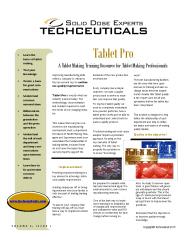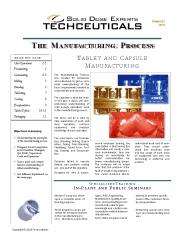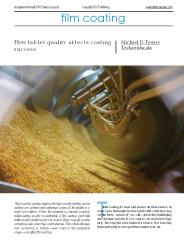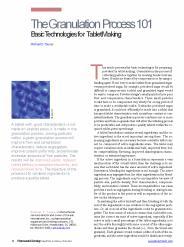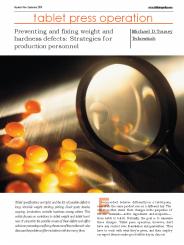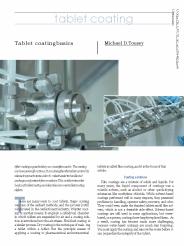Techceuticals PowerPoint PPT Presentations
All Time
Recommended
Tablet Pro Tablet Making Training Resource for Tablet Making Professionals
| PowerPoint PPT presentation | free to download
Tablet and Capsule Manufacturing Process
| PowerPoint PPT presentation | free to download
High-quality coating begins with high-quality tablets, and no coating can achieve peak adherence unless all the tablets in a batch are uniform. When the substrate is prepared properly, tablet coating quality is predictable. A film coating won't hide tablet quality problems and will, in fact, likely magnify quality variations, even when they aren't extreme. This article discusses how variations in tablets - even when in the acceptable range - can affect film coating.
| PowerPoint PPT presentation | free to download
This article presents the basic technologies for preparing powders for tablet making. Granulation is the process of collecting particles together by creating bonds between them. Bonds are formed by compression or by using a binding agent. If one were to make tablets from granulated sugar versus powdered sugar, for example, powdered sugar would be difficult to compress into a tablet and granulated sugar would be easy to compress. Powdered sugar’s small particles have poor flow and compression characteristics. These small particles would have to be compressed very slowly for a long period of time to make a worthwhile tablet.
| PowerPoint PPT presentation | free to download
Tablet specifications are tight, and the list of possible defects is long: Variable weight, sticking, picking, black spots, streaks, capping, lamination, variable hardness, among others. This article focuses on variations in tablet weight and tablet hardness. It pinpoints the possible causes of these defects and offers advice on preventing and fixing the source of the problems. It also discusses the problems of formulations with too many fines.
| PowerPoint PPT presentation | free to download
After making a good tablet, you must often coat it. The coating can have several functions. It can strengthen the tablet, control its release, improve its taste, color it, make it easier to handle and package, and protect it from moisture. This article reviews the basics of tablet coating and describes common tablet coating defects.
| PowerPoint PPT presentation | free to download
The unit operations that precede tabletting are intended to make the powder ingredients work on the press. Granulating, milling, and blending are supposed to improve flow, compressibility, and ejection so that the powders can be controlled precisely to achieve accurate tablet weight, hardness, thickness, friability, disintegration, dissolution, and appearance. Recognize that the tablet press is the report card. It tells you how well you conducted the preceding unit operations.
| PowerPoint PPT presentation | free to download
Sticking occurs when granules attach themselves to the faces of tablet press punches. Picking is a more specific term that describes product sticking only within the letters, logos, or designs on the punch faces. This article explains the causes of sticking and picking and describes the steps you can take to resolve both problems.
| PowerPoint PPT presentation | free to download
Tablet defects bedevil many manufacturers. This article outlines some strategies that tablet production experts use to resolve the most common ones, including weight variation, black spots, capping, and sticking and picking.
| PowerPoint PPT presentation | free to download
When it comes to coating tablets there are musts that really count and then there are the other things.
| PowerPoint PPT presentation | free to download
A tablet press is one of the most complex machines used in the manufacturing environment. Clearly defining the basic principles in tablet press operation is essential to having a successful run. Learning key factors can help to avoid the many obstacles that can interrupt a successful run. Worldwide, more than 18 different companies make tablet presses. All tablet presses operate in the same basic way with only a few exceptions. This fact allowed the industry to define and create a standard for tablet press machines and tablet press tooling, which was published in the Tablet Specification Manual (TSM) by the American Pharmaceutical Association. The TSM can be acquired through any tooling or tablet press supplier. This article discusses how tablet press performance can be optimized by clearly distinguishing between granulation and machine issues; focusing on the importance of flow, compression, and ejection; and performing the necessary maintenance and quality control checks.
| PowerPoint PPT presentation | free to download
How long does it take to clean a tablet press and ready it for the next production run? It’s a question tablet press manufacturers get all the time. They usually reply that it depends on the number of stations, the tooling configuration, the last product made on the machine, maintenance needs, and any number of other variables. And all that’s true, but for a better answer, take a moment to watch a real changeover. Many of you will discover that you’re missing a big opportunity to improve productivity.
| PowerPoint PPT presentation | free to download

